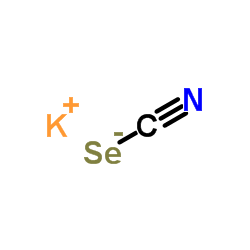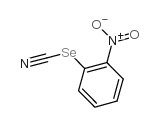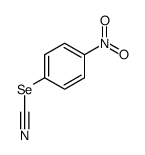硒氰酸钾

硒氰酸钾结构式

|
常用名 | 硒氰酸钾 | 英文名 | Potassium selenocyanate |
|---|---|---|---|---|
| CAS号 | 3425-46-5 | 分子量 | 144.076 | |
| 密度 | 2.347 | 沸点 | 134.2ºC at 760 mmHg | |
| 分子式 | CKNSe | 熔点 | 147 °C | |
| MSDS | 中文版 美版 | 闪点 | 35ºC | |
| 符号 |



GHS06, GHS08, GHS09 |
信号词 | Danger |
硒氰酸钾用途【用途一】 用于有机化学产品和医药的制造,金属的保护涂层及淡化热处理,玻璃的制造,生产防莠剂等。 |
| 中文名 | 硒氰酸钾 |
|---|---|
| 英文名 | potassium,selenocyanate |
| 中文别名 | 硒基氰酸钾 | 氰硒酸钾 |
| 英文别名 | 更多 |
| 密度 | 2.347 |
|---|---|
| 沸点 | 134.2ºC at 760 mmHg |
| 熔点 | 147 °C |
| 分子式 | CKNSe |
| 分子量 | 144.076 |
| 闪点 | 35ºC |
| 精确质量 | 144.883301 |
| PSA | 23.79000 |
| 外观性状 | 白色至淡米色结晶粉末或针状 |
| 储存条件 | 常温,避光,通风干燥处,密封保存 |
| 稳定性 | 常温常压下稳定 |
| 计算化学 | 1.疏水参数计算参考值(XlogP):无 2.氢键供体数量:0 3.氢键受体数量:2 4.可旋转化学键数量:0 5.互变异构体数量:无 6.拓扑分子极性表面积23.8 7.重原子数量:4 8.表面电荷:0 9.复杂度:31.3 10.同位素原子数量:0 11.确定原子立构中心数量:0 12.不确定原子立构中心数量:0 13.确定化学键立构中心数量:0 14.不确定化学键立构中心数量:0 15.共价键单元数量:2 |
| 更多 | 1. 性状:白色或奶油色粉末 2. 密度(g/mL,25/4℃):未确定 3. 相对蒸汽密度(g/mL,空气=1):未确定 4. 熔点(ºC):151-152 5. 沸点(ºC,常压):未确定 6. 沸点(ºC,5.2kPa):未确定 7. 折射率:未确定 8. 闪点(ºC):未确定 9. 比旋光度(º):未确定 10. 自燃点或引燃温度(ºC):不适用的 11. 蒸气压(kPa,25ºC):未确定 12. 饱和蒸气压(kPa,60ºC):未确定 13. 燃烧热(KJ/mol):未确定 14. 临界温度(ºC):未确定 15. 临界压力(KPa):未确定 16. 油水(辛醇/水)分配系数的对数值:未确定 17. 爆炸上限(%,V/V):未确定 18. 爆炸下限(%,V/V):未确定 19. 溶解性:可溶解的 |
|
硒氰酸钾毒理学数据: 急性毒性: 大鼠腹腔LDLo: 200 mg/kg;毒性作用的细节没有报告除此以外的其他致死剂量值 硒氰酸钾生态学数据: 该物质对环境可能有危害,对水体应给予特别注意 |
| 符号 |



GHS06, GHS08, GHS09 |
|---|---|
| 信号词 | Danger |
| 危害声明 | H300-H331-H373-H410 |
| 警示性声明 | P261-P264-P273-P301 + P310-P311-P501 |
| 个人防护装备 | Eyeshields;Faceshields;Gloves;type P2 (EN 143) respirator cartridges |
| 危害码 (欧洲) | T:Toxic;N:Dangerousfortheenvironment; |
| 风险声明 (欧洲) | R23/25;R33;R50/53 |
| 安全声明 (欧洲) | S20/21-S28-S45-S60-S61 |
| 危险品运输编码 | UN 3283 6.1/PG 2 |
| WGK德国 | 3 |
| RTECS号 | VT1400000 |
| 包装等级 | II |
| 危险类别 | 6.1 |
| 海关编码 | 2929909090 |
| 硒氰酸钾上游产品 1 | |
|---|---|
| 硒氰酸钾下游产品 9 | |
| 海关编码 | 2929909090 |
|---|---|
| 中文概述 | 2929909090 其他含氮基化合物. 增值税率:17.0% 退税率:9.0% 监管条件:无 最惠国关税:6.5% 普通关税:30.0% |
| 申报要素 | 品名, 成分含量, 用途 |
| Summary | 2929909090 other compounds with other nitrogen function VAT:17.0% Tax rebate rate:9.0% Supervision conditions:none MFN tariff:6.5% General tariff:30.0% |
|
Synthesis of unnatural selenocystines and beta-aminodiselenides via regioselective ring-opening of sulfamidates using a sequential, one-pot, multistep strategy.
J. Org. Chem. 75(9) , 2910-21, (2010) A variety of N-alkyl-beta-aminodiselenides have been synthesized in high yield from sulfamidates under mild reaction conditions using potassium selenocyanate and benzyltriethylammonium tetrathiomolybd... |
|
|
Nutritional availability and chronic toxicity of selenocyanate in the rat.
J. Nutr. 118(6) , 718-22, (1988) To evaluate nutritional availability and chronic toxicity of KSeCN, female postweanling rats were fed casein-based diets plus 0.1, 0.5, 2.5, 5 and 10 mg Se/kg as KSeCN for 6 wk, or 0.1, 0.5 and 10 mg ... |
|
|
Selenium assimilation and volatilization from selenocyanate-treated Indian mustard and muskgrass.
Plant Physiol. 128(2) , 625-33, (2002) Selenocyanate (SeCN(-)) is a major contaminant in the effluents from some oil refineries, power plants, and in mine drainage water. In this study, we determined the potential of Indian mustard (Brassi... |
| Potassium selenocyanate |
| Potassium selenoisocyanate |
| K(selenocyanate) |
| Selenocyanic acid, potassium salt (1:1) |
| Selenocyanic acid potassium |
| Selenocyanic acid,potassium salt |
| EINECS 222-320-1 |
| potassium selenocyanide |
| potassium ion selenocyanate |
| MFCD00011366 |
| potassium(II) selenocyanate |

 CAS号151-50-8
CAS号151-50-8 CAS号70983-16-3
CAS号70983-16-3 CAS号1116-01-4
CAS号1116-01-4 CAS号51694-22-5
CAS号51694-22-5 CAS号21856-93-9
CAS号21856-93-9 CAS号2179-80-8
CAS号2179-80-8 CAS号19188-18-2
CAS号19188-18-2 CAS号2180-01-0
CAS号2180-01-0 CAS号675-63-8
CAS号675-63-8![chloro-[[chloro(difluoro)methyl]disulfanyl]-difluoromethane结构式](https://image.chemsrc.com/caspic/020/692-58-0.png) CAS号692-58-0
CAS号692-58-0
